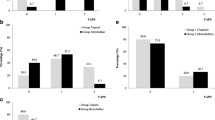Abstract
Aim
To evaluate the effectiveness of bilateral use of topical anesthetic eye drops during phacoemulsification procedure as compared to use in one eye only.
Methods
This is a prospective double-blind randomized case study of 180 cases undergoing phacoemulsification under topical anesthesia using 0.5% proparacaine: Group 1 consisting of patients who had topical anesthetic eye drop instilled into the operating eye only and Group 2 consisting of patients who had both their eyes anesthetized using topical anesthetic eye drops. Phacoemulsification was done using standard surgical technique. Main parameters evaluated included number of intra-operative patient counseling score (IPCS), surgical comfort score (SCS), total phacoemulsification procedure time (TPPT) and total operation time (TOPT).
Results
A comparison of mean value of various variables between Group 1 (60; 33.3% cases) and Group 2 (120; 66.7% cases) using “t” test revealed that there was a statistically significant difference for mean SCS (78.38 ± 10.31 vs. 85.05 ± 8.70; p = 0.00), mean IPCS (12.60 ± 3.11 vs. 6.63 ± 1.74; p = 0.00) and mean TOPT (418.88 ± 89.59 vs. 341.64 ± 79.51; p = 0.00), respectively. However, no statistically significant difference existed for mean TPPT (143.57 ± 87.96 vs. 152.96 ± 78.99; p = 0.48).
Conclusion
Simultaneous instillation of topical anesthetic eye drops in both the eyes, i.e., operating eye and the fellow eye as against practice of instilling topical anesthetic eye drop in the operating eye only, helps in decreasing the total surgical time by primarily shortening the durations of pre- and post-ultrasonic periods of surgery where effective globe stabilization is wanted. This is achieved by better patient compliance, which in turn enhances surgeon’s comfort during phacoemulsification surgery.


Similar content being viewed by others
References
Kershner RM (1993) Topical anesthesia for small incision self-sealing cataract surgery; a prospective evaluation of the first 100 patients. J Cataract Refract Surg 19:290–292
Novak KD, Koch DD (1995) Topical anesthesia for phacoemulsification: initial 20-case series with one month follow-up. J Cataract Refract Surg 21:672–675
Dinsmore SC (1996) Approaching a 100% success rate using topical anesthesia with mild intravenous sedation in phacoemulsification procedures. Ophthalmic Surg Lasers 27:935–938
Hamilton R, Claoué C (1998) Topical anesthesia: proxymetacaine versus Amethocaine for clear corneal phacoemulsification. J Cataract Refract Surg 24:1382–1384
Claoué C (1998) Simplicity and complexity in topical anesthesia for cataract surgery (editorial). J Cataract Refract Surg 24:1546–1547
Boulton JE, Lopatatzidis A, Luck J, Baer RM (2000) A randomized controlled trial of intracameral lidocaine during phacoemulsification under topical anesthesia. Ophthalmology 107:68–71
Koch PS (1999) Efficacy of lidocaine 2% jelly as a topical agent in cataract surgery. J Cataract Refract Surg 25:632–634
Assia EI, Pras E, Yehezkel M et al (1999) Topical anesthesia using lidocaine gel for cataract surgery. J Cataract Refract Surg 25:635–639
Park SW, Lee JE, Choi HY et al (2007) Bell’s phenomenon and conjunctival injury in screening examination for retinopathy of prematurity. J Korean Ophthalmol Soc 48:1694–1698
Nakamori K, Odawara M, Nakajima T et al (1997) Blinking is controlled primarily by ocular surface conditions. Am J Ophthalmol 124:24–30
Karson CN, Berman KF, Donnelly EF et al (1981) Speaking, thinking, and blinking. Psychiatry Res 5:243–246
Agostino R, Bologna M, Dinapoli L et al (2008) Voluntary, spontaneous, and reflex blinking in Parkinson’s disease. Mov Disord 23:669–675
Tsubota K, Hata S, Mori A et al (1997) Decreased blinking in dry saunas. Cornea 16:242–243
Al-Abdulmunem M (1999) Relation between tear breakup time and spontaneous blink rate. Int Contact Lens Clin 26:117–120
Author information
Authors and Affiliations
Corresponding author
Ethics declarations
Conflict of interest
The authors declare that they have no competing interests.
Rights and permissions
About this article
Cite this article
Mannan, R., Pruthi, A. & Khanduja, S. Comparison of surgeon comfort assessment during phacoemulsification using bilateral topical anesthesia versus ipsilateral topical anesthesia: a randomized controlled study. Int Ophthalmol 38, 1235–1242 (2018). https://doi.org/10.1007/s10792-017-0587-2
Received:
Accepted:
Published:
Issue Date:
DOI: https://doi.org/10.1007/s10792-017-0587-2




